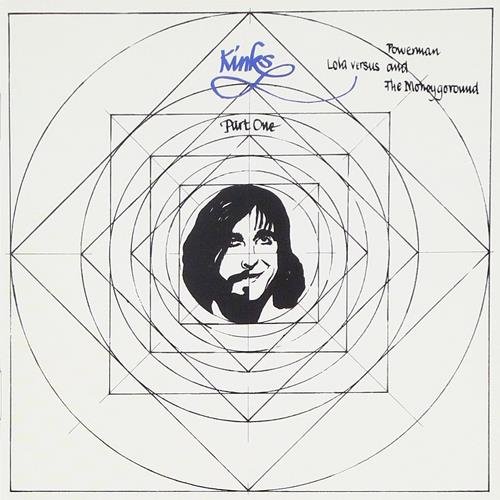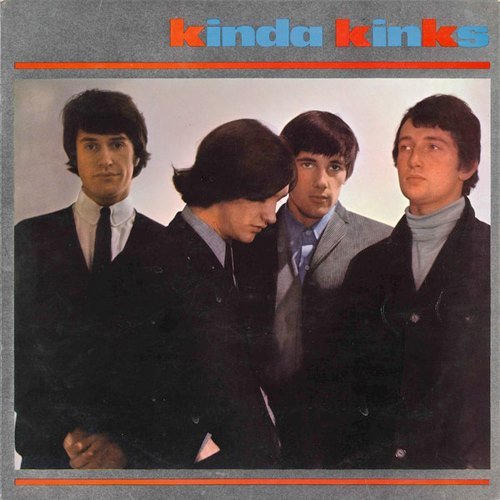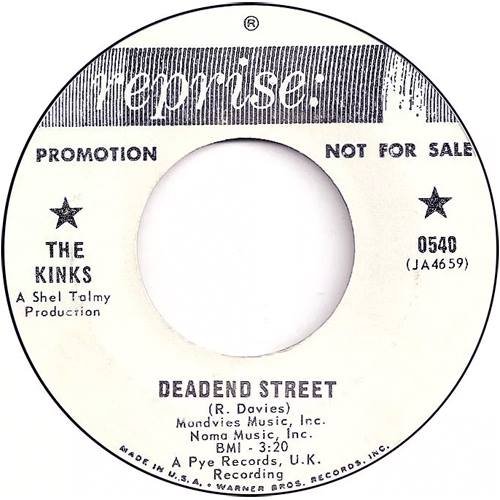Week 47: THE KINKS (420 to 30: A Music Retrospective)
At the height of their popularity and creative output, they were refused permits to perform in the United States. The Kinks would subsequently never reach the popularity of fellow British invaders like The Beatles, The Rolling Stones, and The Who, but not for lack of talent or lack of a robust and deep discography like their contemporaries. The Kinks have been one of those rare bands for me where every layer I pull back further into their catalog, the more I find to like. It is a shame they were cut-off from reaching the audience they deserved, but music never dies.
420 to 30: A Music Retrospective
Here's 7 of my favorites from The Kinks.
Week 47: THE KINKS


#323/420 - The Kinks, “Strangers”
This is the highlight for me from an excellent album by The Kinks, and one that marked a sharp new sound for the group to start a new decade. Lola Versus Powerman and the Moneygoround, Part One is filled with some of their best songs, including “Lola”, “Apeman”, and “Moneygoround”, which come together to be largely thematically centered on lampoonish criticisms of the music industry and society as a whole, something I really appreciate about it.
This song centers on the more personal side of this theme, with lyrics somewhat cryptic. However, however you apply it, it’s tender, earnest, and passionate. Well-produced and such a great, gentle cry, it’s definitely one of my very favorites from The Kinks.

#324/420 - The Kinks, “Ring the Bells”
When it comes to The Kinks, I am a bit of a deep-track fan. While I really enjoy their hits, they have a really deep catalog too, almost at Beatles-level proportions, and this is a simple, melodic such cut from The Kinks’ third album, named in reference to the fact that they were banned from touring in the United States for a number of years.
The restraint in delivery here is great. I really enjoy the calm vocals amid the joyous lyrics. It lets the feeling of the instruments shine. I like simple love songs like this. I’m glad this song was made. It makes me happy to hear it.

#325/420 - The Kinks, “Animal Farm”
My favorite album from The Kinks and their last with the original lineup, this is a song I really love. “This world is big and wild and half insane. Take me where real animals are playing,” is among my favorite opening lines to any song. It’s a quaint song about yearning for a return to life on a farm, but with just the right amount of wildness and edge and silliness, an iconic Kinks sound from a string of their best work.
Walking through a historical village preservation/open-air museum last year showcasing Wisconsin farms from the 1800s, this song was playing in my head throughout the day. Although I did not grow up on one, I have spent extended periods of time living on farms at certain points in my life, and the song does a fine job of taking me back to the best parts of those moments, whether months on my friends’ farm in Colombia, or a single’s afternoon’s walk through old Wisconsin with my mom. I feel the future will hold many more “Animal Farm” moments for me as well.
It’s a good one.

#326/420 - The Kinks, “Nothin' in the World Can Stop Me Worryin' 'Bout That Girl”
Sometimes less is more, and I love this minimalist track from The Kinks’ second album. The vocals are perhaps my favorite by Ray Davies in any song.
The low note at the end and the droning hum to follow are perfect, and full of just the right amount of despondence and dread the lyrics heave with them. The acoustic sound and extremely simple percussion are really great here also. It has a very stripped down feel and it adds to the authenticity and campfire quality it has going for it.
I really appreciate the spectrum of music The Kinks made and this is something of a hidden gem from early on in their careers that I come back to again and again.

#327/420 - The Kinks, “Session Man”
Hail to the harpsichord and hail to the session man. Never has there been such a loving, humorous, enjoyable, and effective homage to session musicians in any rock song. A true character is built here by Ray Davies in the lyrics. His joys, his triumphs, his many faces, but also his place, his tumultuous work schedule, his lack of flash or recognition.
“He’s not paid to think, just play.” Yet there is great joy in this.
All the while one of the era’s great session musicians, Nicky Hopkins, who played with everyone from The Beatles to The Rolling Stones to The Who, is in the background just flying away on the harpsichord.
A really cool fourth-wall-breaking song from one of The Kinks’ best albums.

#328/420 - The Kinks, “Big Black Smoke”
This track was included at the end of my copy of the album Face to Face, and for awhile I thought it was the perfect album closer to any of The Kinks’ albums, until I learned it wasn’t even included on the original album, but only on the b-side of “Dead End Street” (another good one).
Despite being buried in the catalog, this is very nearly my favorite from The Kinks, with some of the best lyrics, vocals, and music from any of their work.
A little country home,
A little country folk,
Made her blood run cold.
Now her mother pines her heart away,
Looking for her child in the big black smoke,
In the big black smoke.
It’s almost like the story of “She’s Leaving Home” by The Beatles, but told from a different perspective. Both are wonderful, but this one has the harder edge to it. Davies’ vocals to start each verse are fantastic in their delivery, and I really enjoy the loud, drunken, shouting quality to them. The church bells and all with the charged, machine gun strumming on the guitar and the rapping on the drums come together exceptionally.
Also not unlike The Beatles, The Kinks were one of those bands that had so much good material, plenty of it didn’t even make it onto their albums, and this is a glowing example of that.

#329/420 - The Kinks, “Village Green”
When it comes to quaint, pleasant, nostalgic songs, few hold a candle to my favorite from The Kinks, the baroque-folk-pop-rock song that led to my favorite album from them as well.
Here Davies’ reflects on England’s village greens, something like community parks, and remembers the simple, bucolic living they provided. Though an American, there was a block of apartments by my house in a somewhat rural area as a kid where some of my best friends lived called “Village Green”, so I guess the verbiage sends me into the past in a similar way, albeit without certainly any American tourists admiring it nowadays.
This was even used as a temporary track in my edit of Batman & Jesus towards the end where we use something stylistically similar written by our composer in the final version.
I love the bounciness of the song and the distinct not-too-excited vocals from Ray Davies, which once again lend very well to the song. I like how the narrator speaks of how he left the village green, but how he will return. There’s sort of an unbelievability to it. It’s a nice thought, but you know you can never go back, as the listener, because the village green as he knew it no longer exists. Daisy is no longer the same. His wistful plan is laid out in vain, but the music dances along gleefully with his unlikely-to-be-realized wishes.
The “la-la-la”s are delightful, with the arcadian band tooting along with them. It comes together to firmly prove The Beatles weren’t the only ones who could knock out a great a great baroque pop song in the 60s.
For all the love The Beatles get, it’s a shame The Kinks are so infrequently part of the same conversation. It’s hard to imagine someone liking one and not the other because of so many shared similarities. They were both part of a distinct genre of rock that is perhaps my absolute favorite type of music, that few artists have ever inhabited, and each have such deep catalogs of it. Even other contemporaries that draw frequent comparisons like The Rolling Stones or The Who were clearly never playing quite the same style of music, although great in their own ways. The Beatles had it, and The Kinks had it, and were The Kinks never banned from touring in America for so many years, perhaps I wouldn’t have to be saying this in this way:
Don’t sleep on The Kinks.
Next week, a more contemporary artist who is also no stranger to bans, and one who was perhaps the king of controversy in America at his peak. His rhymes and lyrics are renowned, with one of the most distinct and impacting deliveries in the business, it’s Slim Shady himself, Marshall Mathers a.k.a. Eminem.
420 to 30: A Music Retrospective
Week 2: The Jackson 5/The Jacksons
Week 3: A Tribe Called Quest
Week 4: Weezer
Week 5: Bob Dylan
Week 6: Led Zeppelin
Week 7: 2Pac/Makaveli
Week 8: Billy Joel
Week 9: Electric Light Orchestra
Week 10: Elvis Presley
Week 11: Dr. Buzzard’s Original Savannah Band
Week 12: The Jimi Hendrix Experience
Week 13: Nirvana
Week 14: The Doors
Week 15: The Rolling Stones
Week 16: Gnarls Barkley
Week 17: Gábor Szabó
Week 18: Galaxie 500
Week 19: Simon & Garfunkel
Week 20: Gorillaz
Week 21: Ennio Morricone
Week 22: The Moody Blues
Week 23: Koji Kondo
Week 24: Rob Zombie/White Zombie
Week 25: Paul McCartney/Wings
Week 26: George Harrison
Week 27: Phil Spector
Week 28: John Lennon/Plastic Ono Band
Week 29: Public Enemy
Week 30: The Love Language
Week 31: Barry White
Week 32: Frank Sinatra
Week 33: David Bowie
Week 34: Queen
Week 35: The Offspring
Week 36: Louis Prima
Week 37: The Notorious B.I.G.
Week 38: Nancy Sinatra
Week 39: Stevie Wonder
Week 40: Roger Miller
Week 41: Röyksopp
Week 42: N.W.A
Week 43: Sly and the Family Stone
Week 44: Herb Alpert and the Tijuana Brass
Week 45: Supertramp
Week 46: "Weird Al" Yankovic
View the full list of "420 Songs" here: https://tinyurl.com/y8fboudu (Google spreadsheet link)